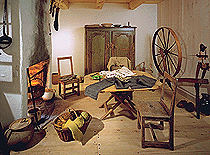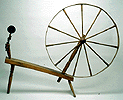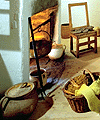Canada Hall
 Farm Life
Farm Life
Along the St. Lawrence River, farms were quite different from those in Acadia. Starting in 1634, farms were designated according to the seigneurial system, where land grants, called seigneuries, were issued to anyone who could attract settlers. A typical seigneury measured 1 x 3 leagues (or 5 x 15 km) and was divided into long, narrow lots facing the river. These lots were similar in shape to farms in Normandy, where many colonists originated. They were ideally suited to the St. Lawrence Valley, as each lot had direct access to the river and to public roads needed to transport produce to market. The close proximity to neighbours reduced the feeling of isolation, which helped people adapt to life in a new land.
Farms were highly diversified operations, designed to produce food for the family, with a small surplus available for sale at local markets. Wheat, a primary crop, was used to produce flour for bread, a staple food in New France. It was rotated with oats, corn, barley, and tobacco. There were also vegetable gardens and fruit trees. The livestock included pigs, cattle, horses, sheep, goats, and poultry. Farm families, however, were never totally self-sufficient. They produced simple tools, clothing from homespun wool and flax, and shoes from hand-cured hides, but for other items, they depended on local artisans, such as blacksmiths and coopers.
 The farmhouse on display is typical of the New France era.
The steep roof shed snow, and the walls were plastered and
whitewashed to prevent the squared logs from rotting. An average
farmhouse measured 8 m x 6 m in size and usually had a thatch or
cedar-shingle roof. Inside, there were normally one or two rooms,
divided by a central fireplace used for cooking and heating. The
furniture was handmade, and the walls were often decorated with
religious symbols.
The farmhouse on display is typical of the New France era.
The steep roof shed snow, and the walls were plastered and
whitewashed to prevent the squared logs from rotting. An average
farmhouse measured 8 m x 6 m in size and usually had a thatch or
cedar-shingle roof. Inside, there were normally one or two rooms,
divided by a central fireplace used for cooking and heating. The
furniture was handmade, and the walls were often decorated with
religious symbols.



Judging by what is shown in the house, it is probably autumn or winter. Furniture repairs were usually done after the harvest, and the fact that clothing is being made and mended suggests that colder weather is on its way.
 Both the habitants
of the St. Lawrence Valley and the
Acadians
built furniture similar to that in France. Their pewterware, pottery and
kitchen utensils were usually imported from France. The Acadians also
obtained supplies from travelling merchants who came from the British colonies
of Massachusetts and New York. In general, the farmers of New France had
an easier
life than their counterparts in the mother country.
Both the habitants
of the St. Lawrence Valley and the
Acadians
built furniture similar to that in France. Their pewterware, pottery and
kitchen utensils were usually imported from France. The Acadians also
obtained supplies from travelling merchants who came from the British colonies
of Massachusetts and New York. In general, the farmers of New France had
an easier
life than their counterparts in the mother country.

